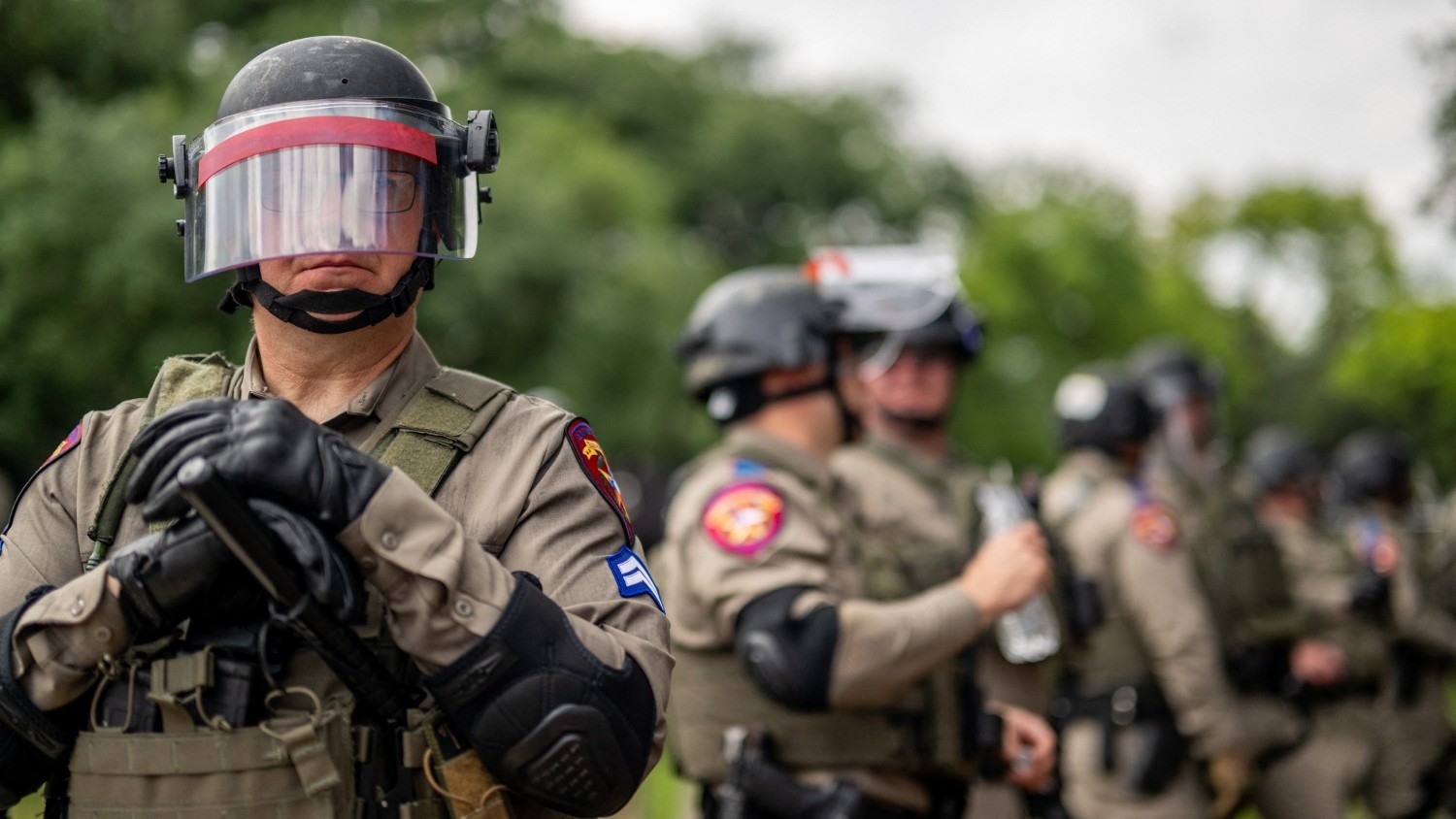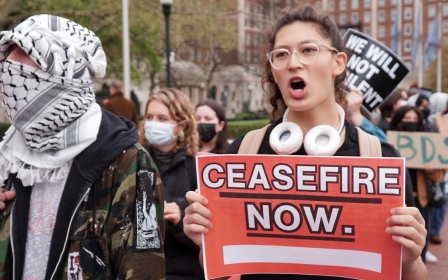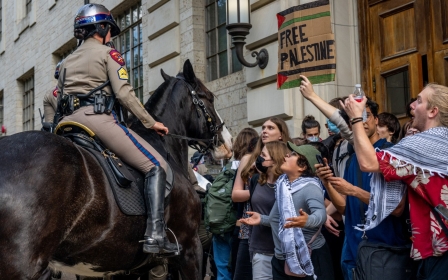Armoured cars and snipers: The police repression of Gaza solidarity encampments

On Tuesday night local time, New York City Police officers wearing riot gear descended upon Columbia University to break up a student encampment set up in solidarity with the people of Gaza.
Dozens of students were arrested, as police used an armoured vehicle to gain entry into one of the university buildings. Officers also used flash bangs to disperse the crowds.
While in many ways Columbia University has been the epicentre of these student demonstrations and the subsequent police crackdown, the scenes of police repression of American students demonstrating in support of Palestine have been mirrored all across the country over the past few weeks.
At least 90 Gaza solidarity encampments have been set up at US universities.
Middle East Eye takes a look at the examples in which police used brute force to disperse, arrest, and attack student demonstrators on college campuses, as well as the breakout of violence set off by the provocation of counterprotesters trying to break in and disrupt these encampments.
Stay informed with MEE's newsletters
Sign up to get the latest alerts, insights and analysis, starting with Turkey Unpacked
UCLA
On Tuesday night, as police descended upon students at Columbia University, a crowd of counterprotesters began to attack a Gaza solidarity encampment set up at the University of California-Los Angeles.
At around 10:50pm local time, pro-Israel supporters arrived at the encampment and launched fireworks at the pro-Palestine protesters and deployed what appeared to be bear spray, according to local reports.
The pro-Palestine students were shown on local media outlets covering themselves from the spray with umbrellas, and at least one person was taken away by ambulance for treatment.
Several videos posted on social media showed pro-Israel supporters wielding sticks and poles, and throwing punches at some of the students.
The Daily Bruin, UCLA's student newspaper, reported that around 100 pro-Israel supporters had stormed the encampment, while police reportedly stood by and "watched".
Emory University
At Emory University in Atlanta, Georgia, police were called in last week to disperse the students' Gaza solidarity encampment, which also was set up in protest against the construction of a police training facility known as "Cop City".
The police crackdown was swift and aggressive, with a video that went viral showing economics professor Caroline Fohlin being tackled to the ground, and her head pinned to the concrete after she called on police to stop using force on a protester.
Another professor, the school's chair of the philosophy department, Noelle McAfee, was arrested by police during the pro-Palestine protests on campus.
Other footage showed Georgia State Police using a taser on another protester.
University of Texas-Austin
At the request of the administration of the University of Texas-Austin, Texas state troopers were quickly called on 25 April to disperse an encampment set up by students.
Police officers in riot gear rolled in on foot, in vehicles and mounted on horses and confronted the protesters, who went on to form a human chain to protect the crowd.
What transpired was a brutal crackdown on pro-Palestinian student protesters, with footage captured and published on social media showing an officer beating a protester.
Other footage captured showed police grabbing a student by their legs and tossing them, and pinning other protesters to the ground.
Police also used pepper spray on student protesters. More than 50 people were arrested.
Northeastern University
On 27 April, around 100 people were arrested at Northeastern University after there were reports of antisemitic language and incendiary rhetoric being used, namely the phrase "kill the Jews".
However, the phrase was found to have come from a pro-Israel protester, not from the students who were engaged in the Gaza solidarity camp.
Nonetheless, police stormed and cleared the encampment.
Washington University St Louis
At the encampment set up at the Washington University of St Louis, police officers slammed to the ground, beat, and dragged a 64-year-old history professor.
Steve Tamari, a professor of Middle East and Islamic history at Southern Illinois University, said he was hospitalised as a result of the violence, "with multiple broken ribs and a broken hand".
University of Wisconsin-Madison
At the University of Wisconsin-Madison, one student told CNN that the campus protest had been peaceful until police arrived on the scene.
Police officers began to line up with shields in front of the student encampment, then started pushing in, forcing the protesters to push back.
Police then proceeded to remove tents from the encampment, which were later set back up by students. Several people were arrested by police, according to local reports.
Ohio State and Indiana University
While similar scenes of police arrests emerged on the campuses of Ohio State and Indiana University, outrage ensued after photos emerged online allegedly showing snipers stationed on the rooftops of schools amid the ongoing Gaza solidarity protests.
The Lantern, Ohio State's student newspaper, reported that the university confirmed that police stationed on the rooftop of one of the campus buildings were in possession of firearms, but said that no weapons were aimed at protesters.
At Indiana University, police confirmed that a sniper was stationed on a rooftop.
"The overwatch location gives us the ability to pay attention to what's occurring overhead, not laterally on the field," Indiana State police superintendent Doug Carter told a local news outlet.
"That got turned into a closed sniper position. Could it have become that? Yes. Was that our intent? No."
University of Arizona
At the University of Arizona, one of the more flagrant examples of excessive force was used on student protesters and the adjacent crowds.
University president Robert Robbins ordered the police to come in and clear out the protesters on Tuesday night.
Police went on to use "chemical irritant munitions" as well as rubber bullets on protesters and also journalists, a move that Robbins said was "in the best interests of our students, faculty and staff to ensure their safety".
Arizona State University
At another institution in Arizona, Arizona State University, police were also called in to disperse encampments at two of the university's campuses.
At least 72 people were arrested amid the police confrontation. One video posted online allegedly showed police forcibly removing the hijab of a Muslim student protester, while reports said that this happened to several Muslim women.
The Arizona chapter of the Council on American-Islamic Relations condemned the incident and said it was investigating further.
University of South Florida
At the University of South Florida, police used tear gas canisters on Tuesday in order to disperse the crowds of pro-Palestian students who had set up their encampment.
While tear gas is a substance that is banned in international warfare, it is often used by police to break up large groups of demonstrators.
While nonlethal, exposure to tear gas can be linked to a number of health issues, such as respiratory failure and blindness.
Middle East Eye delivers independent and unrivalled coverage and analysis of the Middle East, North Africa and beyond. To learn more about republishing this content and the associated fees, please fill out this form. More about MEE can be found here.


